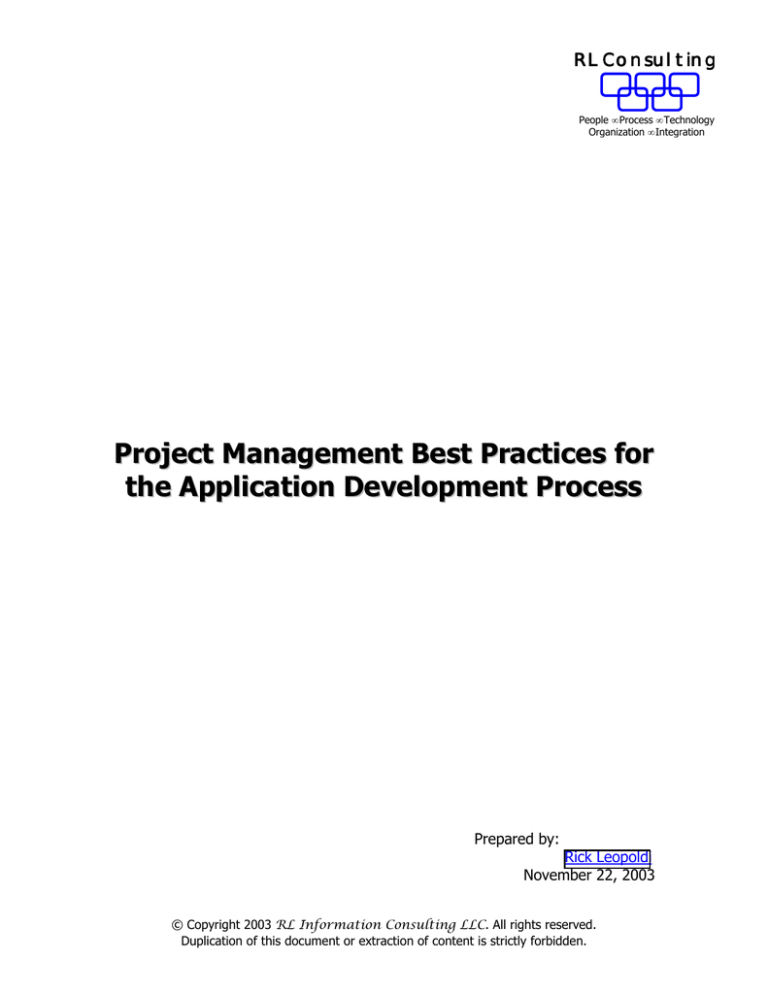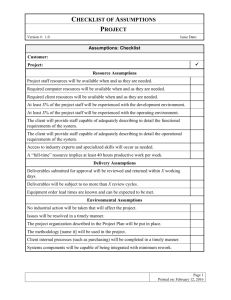
RL Consulting
People • Process • Technology
Organization • Integration
Project Management Best Practices for
the Application Development Process
Prepared by:
Rick Leopoldi
November 22, 2003
© Copyright 2003 RL Information Consulting LLC. All rights reserved.
Duplication of this document or extraction of content is strictly forbidden.
Project Management Best Practices for the Application Development Process
Overview
This paper establishes the essential components for the Requirements Definition
and subsequently each Phase within an Application Development project process.
This includes the primary steps involved in each Phase, and the necessary
“packets” of information that need to be developed and passed from one Phase
to the next.
These necessary components, including a high-level summarization checklist of
activities, are intended to be depict the guiding, final verification, and sign-off
needed to proceed to the next step in the Application Development project
process cycle. In essence, the components of each Phase and packet are
deliverables that are part of, or needed at, the end of each Phase.
RL Information Consulting llc
Page - 1
People • Process • Technology
Organization • Integration
Project Management Best Practices for the Application Development Process
The following Flowchart depicts the Requirements Definition process that should
be done prior to, and as part of the Application Development project process
cycle:
Requirements Definition with Project
Management Methods Flowchart
Determine Project
Need
Develop Vendor
Management Plan
Develop Quality
Management Plan
Develop Risk
Management Plan
Identify Business
End Users and
Stakeholders
Develop Resource
Management Plan
NO
Detail Business
Requirements
Approval
YES
Detail Project
Requirements
Approval
NO
YES
Define Work
(WBS)
Estimate Effort,
Time, Cost, Risk
Develop Budget
and Schedule
NO
Mgt/Exec
Committee
Approval
YES
RL Information Consulting llc
Page - 2
People • Process • Technology
Organization • Integration
Project Management Best Practices for the Application Development Process
Phase 1: Visioning and Business Planning
The purpose of this Phase is to identify the business requirement/need for the
potential project. The outcome of this Phase is approving the initial project plan
that includes but is not limited to the following activities and deliverables that
define:
• Business need
• Stakeholders
• Scope
• Goals
• Critical success factors
• Expected outcomes
• Needs assessment
• Costs
The packet of information that must be completed during and/or by the end of
Phase 1 includes but is not limited to the following:
1) Initial Project Plan – in the form of a Work Breakdown Structure (WBS)
2) Phase Approval and Signoff – for Technical Team and Business Team
3) Project Vision Statement – A high level document to be presented to a
Management and/or Executive Committee
4) Initial CBA – a high level description of the benefits and costs for the
project
5) Phase Signoff Checklist – a document that contains a verification checklist
signoff for stakeholders, customers, application development group,
business end users for each deliverable in this Phase and the verification
and approval to move to the next Phase.
Phase 2: Analysis and Design
The purpose of this Phase is that the business end users drive the analysis and
design in concert with the Application Development project team. The detailed
business processes that will be impacted are determined. The outcomes of this
Phase are:
• Commitment from the business units and departments that they will
provide to the best of their ability the priority and resources to the
development of the business and integration systems in their
departments to accept and distribute information from/to the integrated
system
RL Information Consulting llc
Page - 3
People • Process • Technology
Organization • Integration
Project Management Best Practices for the Application Development Process
•
•
Commitment from the business units and departments responsible for
the post implementation systems operations and support with drafts of
service level agreements (SLA’s)
Approval of the business and technical plan that includes but is not
limited to the following activities and deliverables that define:
Business models
Data models
Prototypes
Costs
Schedule
Estimated milestones
Expected results
The packet of information that must be completed during and/or by the end of
Phase 2 includes but is not limited to the following:
1) More Detailed Project Plan – a follow-on to the Work Breakdown Structure
(WBS) that contains more detailed tasks, durations, resources, and
expertise levels
2) JAD Decision Document
3) Updated Business and Data Models
4) Business Unit Interface Specification
5) Initial ITSM SLA plan
6) Phase Approval and Signoff – for Technical Team and Business Team
7) More Detailed CBA – a follow-on to the high level CBA that provides a
greater description of the benefits and costs for the Application
Development project with qualifications and quantifications for each
8) Phase Signoff Checklist – a document that contains a verification checklist
signoff for stakeholders, customers, application development group,
business end users for each deliverable in this Phase and the verification
and approval to move to the next Phase.
Phase 3: Application Development and Testing
The purpose of this Phase is that the Application Development project team will
develop and test the system. The outcomes of this Phase are the demonstration
of the application in the test environment and review of test results and the
approval to proceed with Operational Testing and Implementation step.
RL Information Consulting llc
Page - 4
People • Process • Technology
Organization • Integration
Project Management Best Practices for the Application Development Process
The packet of information that must be completed during and/or by the end of
Phase 3 that includes but is not limited to the following activities and deliverables
that defines:
1) A Test Project Plan – that contains detailed development and testing
tasks, durations, resources, and expertise levels
2) Test Results
3) More detailed IT Service Management plan that includes Service Level,
Incident/Problem, Change, Configuration, Release, Service Continuity, and
Performance Management
4) Step Approval and Signoff – for Technical Team and Business Team
5) Finalized CBA – a detailed level CBA that provides an in-depth description
of the benefits and costs for the Application Development project with
qualifications and quantifications for each
6) Phase Signoff Checklist – a document that contains a verification checklist
signoff for stakeholders, customers, application development group,
business end users for each deliverable in this Phase and the verification
and approval to move to the next Phase.
Phase 4: Operational Testing and Implementation
The purpose of this Phase is the system to be deployed is moved to the
operational environment for final business end user acceptance testing before
implementation for operational use. The outcomes of this Phase are the review
and approval of the operational environment test results, Approval to implement,
and Implementation.
The packet of information that must be completed during and/or by the end of
Phase 4 includes but is not limited to the following activities and deliverables that
defines:
1) An Implementation Project Plan – that contains detailed implementation,
deployment, and possible recovery tasks, durations, resources, and
expertise levels
2) Disaster Recovery Test Results
3) Further detailed IT Service Management plan that includes Availability,
Capacity, and Financial Management, and Service Desk
4) Step Approval and Signoff – for Technical Team and Business Team
5) Phase Signoff Checklist – a document that contains a verification checklist
signoff for stakeholders, customers, application development group,
business end users for each deliverable in this Phase and the verification
and approval to move to the next Phase.
RL Information Consulting llc
Page - 5
People • Process • Technology
Organization • Integration
Project Management Best Practices for the Application Development Process
Phase 5: Post Implementation Operations and Support
The infrastructure for this step is defined and approved in the Analysis and
Design step. Once the system is deployed to operational use the SLA’s are
put in place and the IT Service Management procedures for Change, Release,
and Incident/Problem, and Service Continuity management take effect.
The packet of information that must be completed during and/or by the end of
Phase 5 includes but is not limited to the following activities and deliverables that
defines:
1) A template set of Project Plans – that contains generic templates for
detailed analysis and design tasks, development and testing tasks,
implementation and deployment tasks, durations, resources, and expertise
levels
2) A Disaster Recovery plan
3) A full IT Service Management Service Delivery and Service Support
methods and best practices
4) Final Project Approval and Signoff – for Technical Team and Business
Team. This is presented to a Management or Executive Committee
5) Final Step and Project Signoff Checklist – a document that contains a
verification checklist signoff for stakeholders, customers, application
development group, business end users for each deliverable in this Phase
and the verification and the approval for all steps.
RL Information Consulting llc
Page - 6
People • Process • Technology
Organization • Integration
Project Management Best Practices for the Application Development Process
Application Development Project Process Activities
PHASE 1:
Visioning and
Planning
Project Phases with Project Management
Methods Flowchart
Draft Initial
Scope and
Vision
Mgt/Exec
Vision
Session
Draft Initial
Scope and
Vision
NO
Approve
Vision
YES
Tech/Bus
Team Review
and SignOff
PHASE 2:
Analysis and
Design
Develop Draft
CBA
Develop Initial
WBS
Budget and
Staff
Estimates
Draft Project
Plan
Develop
Business
Model
Develop Data
Model
Define
Requirement
Specification
Develop
Prototype
Define
Technical and
Business
Interfaces
Determine IT
Service Level
Requirement
Develop
Analysis and
Design Rept
NO
NO
Tech/Bus
Team Review
Reqt Spec
YES
Tech/Bus
Team
Approval
YES
Go to Phase 3:
Development
and Testing
RL Information Consulting llc
Page - 7
People • Process • Technology
Organization • Integration
Project Management Best Practices for the Application Development Process
From Phase 2:
Analysis and
Design
Establish
Technical
Infrastructure
PHASE 3:
Development and
Testing
Migrate to
Production
Technical
Infrastructure
Develop
Integrated
Design
NO
Operational
Test and
Evaluation
YES
Technical
Infrastructure
Install
Operational
Approval
and Cutover
Design and
Develop
Applications
NO
YES
Tech/Bus
Team Review
and SignOff
Unit Test
NO
PHASE 4:
Operational Testing
and Implementation
Unit Test and
Evaluation
Change
Management
PHASE 5:
ITSM PostImplementation
Support Processes
YES
Unit Test
Approval
and Cutover
Incident/
Problem
Management
NO
YES
Release Level
Management
Tech/Bus
Team Review
and SignOff
Service
Continuity
Project Plan
Overview
Financial
Management
and Budget
Team and
Skill Set
Project
Management Tasks
Detailed
Project Plan
(Schedule,
Resources,
Milestones)
Configuration
Management
Additional ITSM
Support Processes
Risk Plan
Performance/
Capacity
Management
Tech/Bus
Team Review
and SignOff
Service (Help)
Desk
RL Information Consulting llc
Page - 8
People • Process • Technology
Organization • Integration

